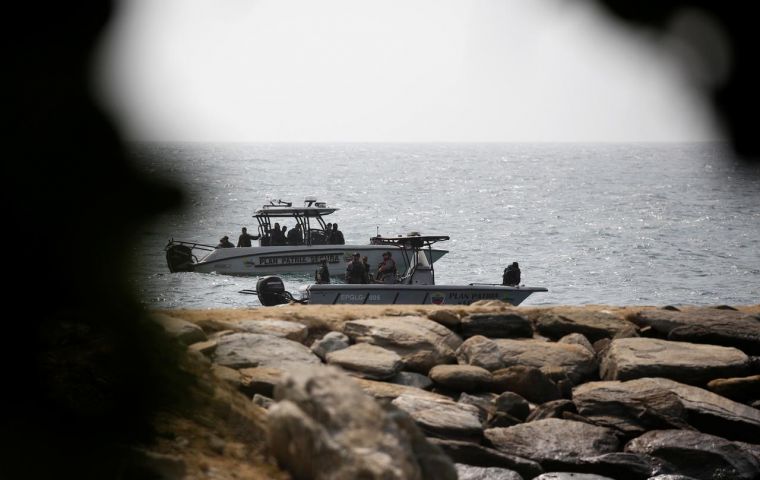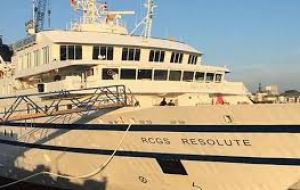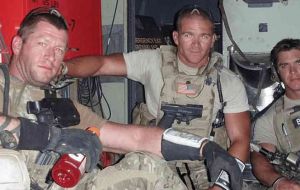MercoPress. South Atlantic News Agency
The failed operation to oust Maduro by a Canadian mercenary ex Green Beret
 By late March, the Venezuelan government was on hair-trigger alert for Goudreau’s planned raid
By late March, the Venezuelan government was on hair-trigger alert for Goudreau’s planned raid  The Venezuelan navy spotted a Canadian-owned cruise-ship, the RCGS Resolute, stopped off the Venezuelan island of Tortuga
The Venezuelan navy spotted a Canadian-owned cruise-ship, the RCGS Resolute, stopped off the Venezuelan island of Tortuga  Jordan Goudreau (center) after joining the Canadian army reserves, moved to the US and joined the Green Berets
Jordan Goudreau (center) after joining the Canadian army reserves, moved to the US and joined the Green Berets By Gwynne Dyer – It's hard being born Canadian if your ambition is to be a real-life version of movie tough guy Jean-Claude Van Damme (Blood Sport, Death Warrant, Universal Soldier, Last Action Hero). The same goes for being Belgian, of course, but Van Damme just wanted to be in the movies.
Jordan Goudreau wanted the real thing, and joining the Canadian army reserves while studying computer science at the University of Calgary didn’t quite do it for him. So he moved to the United States and joined the Green Berets, which provides a much better mix of derring-do, martial arts, and exotic foreigners to kill. ( Sudden Death, Die Fast Die Furious, 6 Bullets, Kill ‘Em All).
Goudreau was not a fake. He did several tours in Afghanistan and Iraq, killing real people, and by all accounts, he was a brave and competent soldier. But action heroes have early expiry dates.
At 60, Jean-Claude Van Damme is doing self-mocking tough-guy commercials for Coors Light. Goudreau’s luck ran out in 2016, when he was injured in a parachute accident and had to retire from his beloved Special Forces at the age of 40.
Nobody offered him any beer commercials, and his great idea to sell the services of military veterans to schools to stop mass shooters – parents would pay a subscription of US$8.99 a month – didn’t fly. So he ended up doing what washed-up American action heroes always do: he went to Latin America ( Butch Cassidy and the Sundance Kid, The Magnificent Seven, etc).
Specifically, he went to Colombia. Having set up a ‘security company’ called Silvercorp in Florida, he got in touch with the Venezuelan congressional leader who claims to be the legitimate president, Juan Guaidó, offering to overthrow Nicolás Maduro (who actually lives in the presidential palace).
This would be done in the time-honored way, by recruiting and training exiles and mercenaries who would go in, attack the regime, and trigger a mass uprising. (Think the 1961 Bay of Pigs invasion of Cuba, only successful.) And for about two weeks last October, Guaidó was tempted.
He even signed a US$213 million contract with Goudreau’s Silvercorp for unspecified “general services”, but he cancelled the contract in early November. Maybe Guaidó is not quite as gullible as he seems, or maybe he just remembered that hiring foreigners to overthrow your country’s government, even in the name of democracy, is a bad look.
Anyway, that was the end of the grand plan, but Goudreau didn’t quit.
The US government had recently declared Maduro a ‘narcoterrorist’ (whatever that is) and put a US$15 million price on the Venezuelan dictator’s head. So Goudreau’s Plan B was to send in a crack team (they’re always called ‘crack teams’) to capture Maduro, airlift him out of the country, and collect the reward.
By now, Venezuela’s intelligence service and practically everybody else knew about Goudreau’s plan. The Associated Press even ran a story about it on May 1, quoting associates of Goudreau as saying that he was “in way over his head”. But before we get to the end of the story, a brief pause to contemplate the equally spectacular incompetence of the other side.
By late March, the Venezuelan government was on hair-trigger alert for Goudreau’s planned raid, and on the 30th, the Venezuelan navy spotted a Canadian-owned cruise-ship, the RCGS Resolute, stopped off the Venezuelan island of Tortuga. So the navy patrol ship Naiguatá ordered the ship to proceed to port for inspection.
Resolute didn’t move because it couldn’t. It had already suffered some mechanical failure and put out a warning that it was ‘not under command’. But the Venezuelans thought it was stalling, and after firing some shots at or near the cruise ship, it started ramming it repeatedly on the starboard bow, apparently trying to force it around in the right direction.
Now, Naiguatá was not some little speedboat. It was a 90-metre steel ship with a crew of 44 and a helicopter on the aft deck. But Resolute has four times the displacement, and its hull is ice-strengthened for cruising in polar waters. Ramming it was like running at a brick wall again and again with your head, hoping to make an impression. Eventually, the Naiguatá just sank.
Another ship picked up its crew, and eventually Resolute got going again. It’s now parked in Curaçao, and no, there weren’t any mercenaries aboard. No passengers of any kind, in fact.
And finally, the tragicomic end. A few dozen volunteers and mercenaries tried to land on the Venezuelan coast near Caracas a week ago. Six were killed, all the rest were arrested. Goudreau would have been there, too – “‘He would have 100 per cent gone out in a blaze of gunfire because that’s who he is,” said a friend – but he couldn’t leave Florida because of coronavirus travel restrictions.




Top Comments
Disclaimer & comment rulesCommenting for this story is now closed.
If you have a Facebook account, become a fan and comment on our Facebook Page!